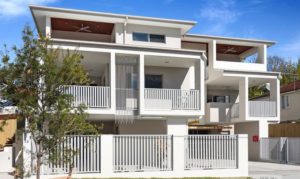Units are a popular choice for investors, yet over development in certain areas can stifle capital growth and make it hard to find a suitable tenant. Understanding the development cycle can be a useful guide to help minimizing potential risk.
National Property Buyers Queensland State Manager, Steve McGee recently purchased a two bedroom unit in Nundah for an interstate client. The client had specific criteria they wanted to meet and after a number of unsuccessful trips to Brisbane decided they needed help, so Steve was engaged.
Steve began searching and soon located and secured a property in a boutique block of units that ticked all of the client’s boxes: the area wasn’t already over supplied, not on a main road, close to amenities and transport infrastructure, and an easy commute to the CBD.
The unit itself is a quality investment situated in a quiet residential street. Constructed to owner occupier’s specifications, it has a large spacious 75sqm interior, two bedrooms, two bathrooms and a 15msq balcony with excellent views and also offering secure undercover parking. Steve was also able to secure a superb result for the buyer. Listed at $465,000, Steve negotiated a purchase of $452,500, saving them $12,500.

Steve recognized the excellent value in this block of units that he actually purchased a second.
Understanding and recognising the stage of the development cycle can be a crucial insight for investors, according to Steve. Nundah is at the end of its development cycle, mitigating the risk of overdevelopment which could potentially make it more difficult to source a tenant and hamper the capital growth.
“Most buyers know that capital cities are over developed. That density of construction makes it really hard for properties to hold their value and as a result we don’t recommend them to clients” Steve said.
“That cause can have the same effect in outer CBD areas, only on a smaller scale”.
Buying at the beginning of the development cycle means that a property will have to compete with more and more new stock, which makes it difficult for investors to secure maximum rent. From a tenant’s point of view, this can be a great thing – with more stock comes more choice and cheaper rent.
So what should investment buyers think about when they look to purchase a unit in a developing area?
Obviously, the number of construction sites in an area are a good indication.
“Buyers need to be aware of the level of development in the area; are there still blocks being knocked down by developers, or has construction generally slowed?” said Steve.
Investors should also be aware of the density of the blocks under construction. It’s not only the number of blocks being constructed, but also the number of units.
“Buyers should consider the type of development. Is there a prevalence of high density blocks, or are they more boutique? For example, anything up to 10 units is generally considered a boutique block”.
For most buyers, discovering these details can be easier said than done.
“In this sort of situation, a Buyer’s Agent can be incredibly helpful to a buyer” said Steve.
“The Buyer Agent will be able to utilise their knowledge of the industry and contacts to investigate if there are any developments in the pipeline in a particular area. That sort of resource will go a long way to helping the buyer minimize any potential risk.”
For advice on securing the best quality property, speak to your property professional.
